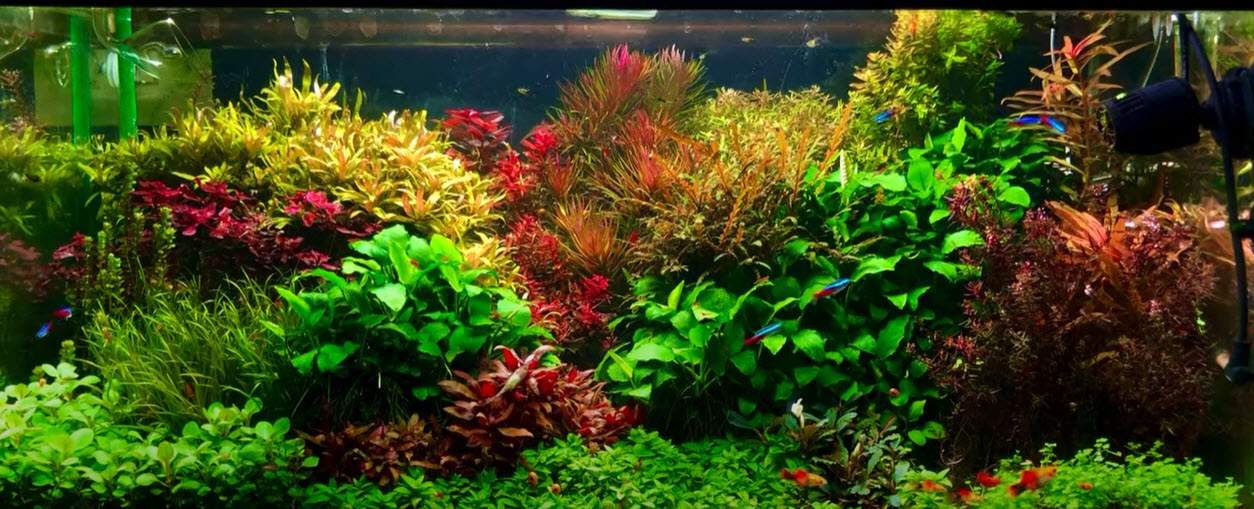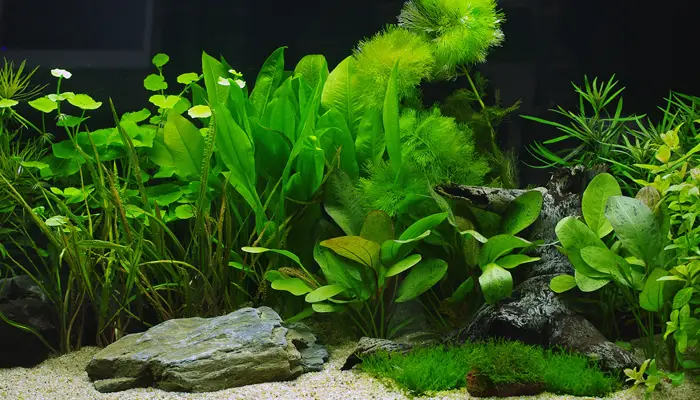By ProHobby™ — Delhi NCR’s Authority in Scientific Aquascaping
Most planted tanks struggle not because of lighting or “weak fertilizers,” but because the chemistry inside the water column becomes the bottleneck.
This Level-2 guide dives deeper into:
- How plants actually acquire carbon, nitrogen, phosphorus, potassium, and micros at the ionic level
- How Delhi NCR hard water (high KH/GH) affects nutrient availability
- How chelation, pH drift, CO₂ forms, and substrate cation exchange define long-term stability
- Why algae blooms are often ionic competition events, not simply “excess nutrients”
This article pairs with the beginner and intermediate guides:
Level 0: 👉 “Nutrients, CO₂ & Algae — The Balancing Act Behind Thriving Planted Aquariums”
Level 1: Advanced Aquarium Fertilization & CO₂ Chemistry Explained
(We recommend reading Level 0 & 1 first.)
⭐ SECTION 1 — Carbon Chemistry: The True Limiting Factor
1.1 CO₂ Forms in Water: Only One Is Readily Usable
Dissolved CO₂ exists in three primary forms:
| Form | % at pH 6.6 | % at pH 7.4 | Plant-usable? |
|---|---|---|---|
| CO₂ (aq) | ~70–90% | ~18–25% | ✔️ Yes |
| HCO₃⁻ (bicarbonate) | ~10–20% | ~70–80% | ⚠️ Mostly No (except some species) |
| CO₃²⁻ (carbonate) | <1% | 1–3% | ❌ No |
Delhi NCR’s high KH pushes tanks toward pH 7.4–8.0 → drastically reducing CO₂ (aq).
This means two tanks with identical CO₂ injection rates can have completely different usable CO₂ levels.
Why this matters:
- Hygrophila, Rotala, Ludwigia = strongly prefer CO₂ (aq)
- Some crypts/vals = can use limited bicarbonate (HCO₃⁻)
- High-KH water = you lose a huge fraction of usable carbon
Thus, CO₂ injection in Delhi is not a “luxury” — it is a necessity to overcome water chemistry.
⭐ SECTION 2 — Micro & Macro Nutrient Ion Competition
Nutrients compete inside the water column and at root interfaces. The most important relationships:
2.1 Potassium vs Calcium/Magnesium (K⁺ vs Ca²⁺/Mg²⁺)
When GH is very high (common in Delhi):
- Ca²⁺ and Mg²⁺ outcompete K⁺ at root exchange sites.
- Result: classic potassium deficiency even when dosing correctly.
Typical symptoms:
- Pinholes in older leaves
- Marginal necrosis
- Weak new growth
ProHobby™ solution:
- Slightly elevated K dosing
- Substrate refresh to reduce Ca loading
- Balanced GH/K ratio
2.2 Iron vs Phosphate (Fe vs PO₄³⁻)
In high pH water, Fe²⁺ (usable) rapidly oxidizes into Fe³⁺ (unusable) → then reacts with PO₄³⁻ → precipitates.
If your Fe and PO₄ dosing “disappear”, this is why.
The solution:
- Use chelated iron (EDTA, DTPA, or EDDHA depending on pH)
- Dose Fe micros and PO₄ at least 4–6 hours apart
- Maintain pH 6.4–6.8 for maximum Fe stability
2.3 Ammonium vs Nitrate (NH₄⁺ vs NO₃⁻)
New aquasoil provides NH₄⁺, which plants prefer—but algae fight harder for it.
Result:
- In the first 4–6 weeks, ammonia spikes → algae opportunities
- Leaner dosing + heavy water changes help stabilize the ratio
⭐ SECTION 3 — Chelation Chemistry & Stability
Chelates prevent metal ions from precipitating. Different chelates behave differently depending on pH:
| Chelator | Stable pH | Best For |
|---|---|---|
| EDTA | 5.0–6.5 | Low pH tanks |
| DTPA | 5.0–7.5 | Most planted tanks |
| EDDHA | 6.0–9.0 | High pH / hard water tanks (Delhi) |
For Delhi NCR:
DTPA is usually ideal, but EDDHA is unmatched for extreme hardness or non-CO₂ tanks.
⭐ SECTION 4 — Substrate Ion Exchange & Nutrient Retention
Advanced substrates (ADA, Tropica, Stratum) have CEC (cation exchange capacity).
CEC does 3 things:
- Stores K⁺, NH₄⁺, Ca²⁺, Mg²⁺
- Releases them back to the plant roots
- Buffers nutrient spikes, keeping water stable
Cheap sand/gravel = no CEC, meaning:
- Nutrients stay in water column → algae sees them first
- Plants starve at the roots
- Requires dosing every single day
- Higher long-term cost
This is why substrate quality matters enormously.
⭐ SECTION 5 — NPK Ratios & Limiting Nutrients
Different plant groups have different nutrient priorities:
| Plant Type | N | P | K | Special Note |
|---|---|---|---|---|
| Stem plants | High | Medium | High | Respond strongly to NO₃ levels |
| Rosette plants (Echinodorus, Crypts) | Medium | Medium | High | Prefer ammonium in early stages |
| Mosses | Low | Low | Medium | Sensitive to Fe spikes |
| Red plants | Medium | Low | High | Require extremely stable CO₂ + micros |
Thus, “one-size-fits-all” dosing is never optimal.
⭐ SECTION 6 — Algae as a Chemical Imbalance Indicator
Algae appears due to imbalance, not excess:
| Algae Type | Cause | Chemical Issue |
|---|---|---|
| BBA | CO₂ instability | DCO₂ swings > 5 ppm |
| GDA | Phosphate misbalance | Fe–PO₄ precipitation |
| GSA | Low PO₄ | <0.5 ppm |
| Hair/Thread algae | Ammonia presence | New substrate, filter lag |
| Diatoms | Low silica competition | Young tanks, weak bio-seeding |
Understanding what algae means chemically is the key to fixing it instantly.
⭐ SECTION 7 — Practical Dosing Framework for Delhi NCR
With CO₂ Injection
- Maintain CO₂ = 25–30 ppm stable
- NO₃: 10–20 ppm
- PO₄: 1.0–2.0 ppm
- K: 15–25 ppm
- Micros: Fe 0.1–0.2 ppm per week (chelated)
- GH: 3–6 dGH
- KH: 0–2 dKH if using RO; 4–6 natural
Without CO₂
- Lower NO₃: 5–10 ppm
- PO₄: 0.2–0.4 ppm
- K: 10–15 ppm
- Micros: 50% of CO₂ tank levels
- GH: 5–8 dGH
- KH: 4–8 dKH
Non-CO₂ tanks require lean dosing, stable light, and higher patience.
⭐ SECTION 8 — When to Move to “Level 3 Chemistry”
You’re ready for Level 3 when:
- You test Fe and PO₄ at multiple times per day
- You adjust CO₂ bubble rate based on photosynthesis start time
- You run a water-column ion balance spreadsheet
- You monitor oxidation-reduction potential (ORP)
- You tailor chelates based on seasonal changes
Yes — hobbyists at ProHobby™ really do this.
⭐ Conclusion: Advanced Chemistry Is the Real Secret Behind Perfect Aquascapes
Beautiful tanks look artistic—but they are scientifically stable ecosystems.
Understanding nutrient ion behavior, chelation, KH/GH effects, carbon chemistry, and competition dynamics elevates your aquarium to a professional level.
For real-world setups, tuning, and troubleshooting, ProHobby™ provides:
- Custom nutrient plans as per your water parameters
- CO₂ calibration
- Water chemistry correction
- Substrate optimization
- Full aqua-ecosystem redesign
Your aquascape becomes predictable, replicable, and algae-proof once the chemistry is correct.
#AdvancedAquascaping, #PlantedTankScience, #AquariumChemistry, #CO2Injection, #NutrientDynamics, #AquascapeOptimization, #DelhiAquascaping, #HardWaterAquarium, #HighTechAquarium, #MacroMicrosBalance, #AquariumFertilization, #ChelatedIron, #AquariumSubstrateScience, #CECSubstrate, #AquariumCO2Stability, #AquariumWaterParameters, #AquariumIonicBalance, #ProfessionalAquascaping, #ProHobby


